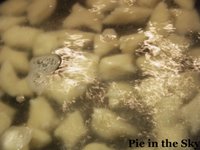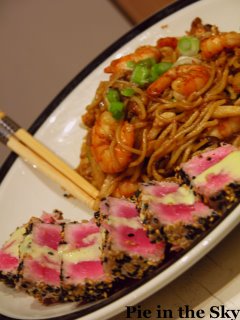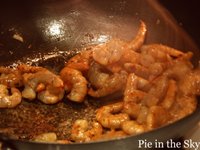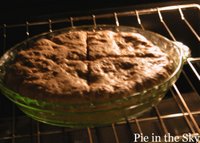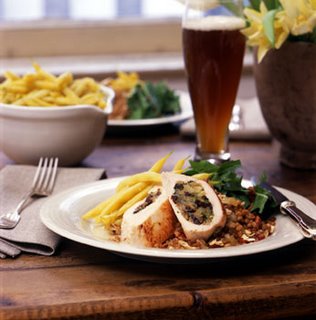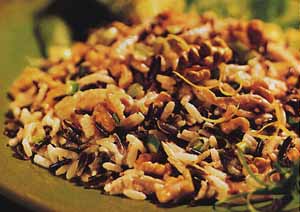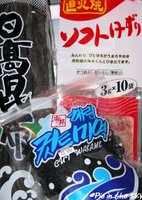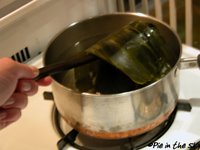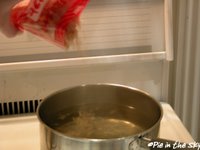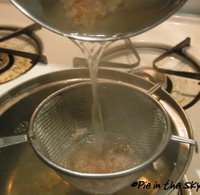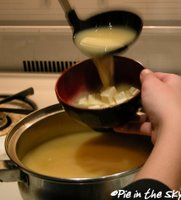
It strikes me that many of my readers are Times-reading, green-market-shopping New Yorkers, or activist students, or self-proclaimed foodies, or food bloggers themselves. But when not in the haven of you hippie-foodie-blogger-activist-environmentalist-Slow-Food-yoga-types that constitute half of my readership, I’m in the company of the other half—those good, decent, no-nonsense Southern folk who wouldn’t be caught dead asking a Piggly-Wiggly employee where the organic section is. Boy, can they cook!...but when discussing issues like the genetic engineering of food, the dangers of pesticide use, monoculture cropping, or buying local vs. imported produce with them, I seldom get more response than a placatory “well you young people just know so much these days” or “it must be nice to have the time and money to think about things like that.” Even worse, young greenies like me get derided as paranoid conspiracy theorists—the logic is that if the generation before mine survived the inauguration of chemical pesticides, etc. (not the least of which was DDT), what have I to fear from my food?
engineering of food, the dangers of pesticide use, monoculture cropping, or buying local vs. imported produce with them, I seldom get more response than a placatory “well you young people just know so much these days” or “it must be nice to have the time and money to think about things like that.” Even worse, young greenies like me get derided as paranoid conspiracy theorists—the logic is that if the generation before mine survived the inauguration of chemical pesticides, etc. (not the least of which was DDT), what have I to fear from my food?
Quite a lot, actually. The Future of Food, a new documentary by Deborah Koons Garcia, elucidates the major food issues that ultimately affect us all…as well as the fact that as time passes, these issues expand and compile on younger generations.
The Future of Food, a new documentary by Deborah Koons Garcia, elucidates the major food issues that ultimately affect us all…as well as the fact that as time passes, these issues expand and compile on younger generations.
The film focuses heavily on the effects of prolific genetically modified foods on people, biodiversity, and politics. Here’s how the GM (genetic modification) problem breaks down with regard to health, the politics of agriculture, and the environment:
Health:
Foods can be genetically modified to numerous ends—to make bigger bananas, longer-lasting apples, peaches resistant to bruising…even corn pre-infused with pesticides—on a genetic level! When Monsanto, the progenitor of the pesticide Roundup, started distributing seeds that are “Roundup Ready,” what that meant was that the seeds had been genetically altered to include the pesticide in their biological make-up. When an ear worm nibbled into an ear of corn, it died! If a person eats that ear of corn, they appear to be fine…but if they ate a spoonful of Roundup, they wouldn’t be. The bottom line is that all of these genetic modifications have been pushed through the FDA without sufficient testing, particularly for long-term effects. No one really knows, yet, exactly what those effects will be, or how the redesigned genes will continue to recombine. Viruses and parasitic bacteria, and pieces of their DNA, are used to modify genes, and scientists are concerned that the recombined genes could become unstable and even contribute to human immunity to antibiotics.
The bottom line is that all of these genetic modifications have been pushed through the FDA without sufficient testing, particularly for long-term effects. No one really knows, yet, exactly what those effects will be, or how the redesigned genes will continue to recombine. Viruses and parasitic bacteria, and pieces of their DNA, are used to modify genes, and scientists are concerned that the recombined genes could become unstable and even contribute to human immunity to antibiotics.
It’s interesting to note that while GM foods have been connected to various cancers, immune suppression, allergies, asthma, and birth defects, they haven’t been modified in any ways that benefit the consumer. Like, tasting better, for instance. In fact, most GM foods have been proven to contain up to 70% less nutrients than conventional foods.
Politics:
Did you know that life can be patented? US law used to omit biotic life from patentable items; this was amended with the onset of GM foods. Now, a company can own all seeds with a specific permutation—and thus, all descendants of these seeds. Thus, when an organic canola farmer in Canada found that a Monsanto truck had spilled GM wheat seeds into his organic fields, he tried to sue them—but Monsanto sued back for property theft…and won.
With corporate super-giants like Monsanto distributing GM seeds worldwide for very little cost, it is cheaper for small farmers (American and otherwise) to buy them than to reserve and sow their own seed. In the US, even industrial farms are struggling, breaking even at the end of a season only after the government subsidies kick in. In fact, most members of the few agricultural families left in the US work outside jobs as well—and pay tax dollars that support subsidized GM farms that further burden farmers.
Most GM products have been banned in the UK; in most places, GM companies are required to label their foods “genetically modified.” In the US, this is not the case. Not only is GM produce unlabeled, but packaged products containing GM ingredients aren’t either—most sweet things that contain high-fructose corn syrup, for instance. Do we not, as Americans, have the right to know?

Environment:
The situation jeopardizes the biosphere, as well. There used to be hundreds of different kinds of potatoes grown and consumed in Europe and North America; now there are only four. Same goes for corn, wheat, tomatoes…you name it. Not only is this depletion of biodiversity just sad, it endangers all species that rely on food biodiversity—including humans. In parts of Africa, for instance, US agribusiness distributed GM rice seeds for almost no cost, and the rice was vitamin-enriched, faster-growing, and the stalks were taller—ostensibly a generous gesture. Farmers who had previously grown a dozen varieties of rice began growing only one, and after about five years of genetically modified plenty, their old stores of local rice weren’t cultivatable anymore. But then a big storm comes along, and all the tall stalks are ripped down. Normally, with a variety of kinds and heights of stalks, a disaster like this would only damage about 10% of their crop—but with the GM rice, they lose more that 75%. Alternatively, a particular insect, or a disease, could blight the GM crops, and instead of only losing a little, the farmers (and thus the communities that subsist on the produce of those farms) lose everything. People and animals starve.
(Deep breath) So. That’s a lot of information—and this is just about GM foods (to the exclusion of topics like pesticides, antibiotics, animal treatment, importation…) But what does it mean in terms of my mom going to the supermarket?
Buy local. The average item in the American shopping cart came 1,500 miles to get there. That’s a tremendous waste of energy! Conserve energy and support American and local farmers by buying locally-grown and produced food whenever possible. Greenmarkets and CSAs (Community Supported Agriculture) are popping up all over the country—see if there’s one near you!
Shop organic. What does organic mean? For a product to be organic-certified means no genetic modification, no hormones or antibiotics, no pesticides. Protect your health and that of your children.
Thanks for reading my diatribe and taking it seriously. For more information about the Future of Food, visit their website; to buy the DVD, visit Amazon. It’s also available on Netflix.
And for all you like-minded greenies out there—sorry for all the information that I omitted. These are vast, complex issues, and there’s a lot to be said about each of them. I welcome your comments and directions to other sources of information. Thanks!

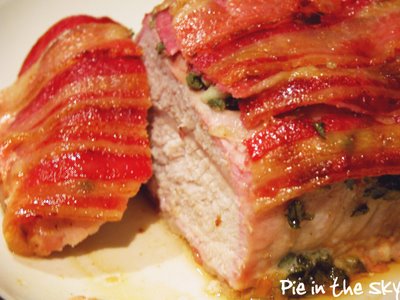









 I try not to get too excited because I know that, in all likelihood, we still have a couple of weeks of cold weather in store...but even i can't help noticing the obvious...spring is almost here!
I try not to get too excited because I know that, in all likelihood, we still have a couple of weeks of cold weather in store...but even i can't help noticing the obvious...spring is almost here!




